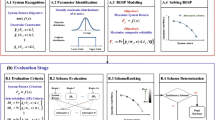Abstract
Pipe breaks in municipal water distribution networks may cause serious damage economically and socially. Existing methods for replacement scheduling of pipes do not provide practical indicators for replacing an individual deteriorated pipe. This work formulates the selection problem as the decision of preference ordering or ranking and proposes a bipartite ranking-based approach. The suggested approach also considers loss from broken pipes in terms of the costs associated with broken water main and its repair. We use rank aggregation method to integrate multiple ranks into replacement order of water mains. The suggested framework prioritizes current pipe sections for replacement based on the aggregated ranks. Multiple ranks given by the reliability of water pipe sections are aggregated and a cost effective policy for pipe replacement is derived.
Similar content being viewed by others
References
Korea waterworks management institute, K-water (2012).
Deloitte, the Ministry of the environment of Korea (2012).
Y. Kleiner and B. Rajani, Urban Water, 3, 131 (2001).
S. A. Andreou, D. H. Marks and R. M. Clark, AdWR, 10, 2 (1987).
R. Jafar, I. Shahrour and I. Juran, MComM, 51, 1170 (2010).
H. Fares and T. Zayed, J. Pipeline Syst. Eng. Practice, 1, 53 (2010).
R. A. Francis, S.D. Guikema and L. Henneman, Reliab. Eng. Syst. Saf., 130, 1 (2014).
Y. Kleiner and B. Rajani, In Proceedings, World Environmental and Water Resources Congress, 1 (2008).
A. Debón, A. Carrión, E. Cabrera and H. Solano, Reliab. Eng. Syst. Saf., 95, 43 (2010).
S. Yamijala, S.D. Guikema and K. Brumbelow, Reliab. Eng. Syst. Saf., 94, 282 (2009).
R. Wang, W. Dong, Y. Wang, K. Tang and X. Yao, IEEE 29th International Conference on Data Engineering, 1208 (2013).
Q. Xu, Q. Chen, J. Ma and K. Blanckaert, J. Hydro-Environ. Res., 7, 134 (2013).
G. Dandy and M. Engelhardt, J. Water Resources Planning Manage., 132, 79 (2006).
L. Dridi, A. Mailhot, M. Parizeau and J.-P. Villeneuve, J. Water Resources Planning Manage., 135, 344 (2009).
J. Nicklow, P. Reed, D. Savic, T. Dessalegne, L. Harrell, A. Chan-Hilton, M. Karamouz, B. Minsker, A. Ostfeld and A. Singh, J. Water Resources Planning Manage., 136, 412 (2009).
G.V. Loganathan, S. Park and H. Sherali, J. Water Resources Planning Manage., 128, 271 (2002).
S. Park, H. Jun, B. Kim and G. Im, Water Resour. Manage., 22, 1311 (2008).
P. Le Gauffre, H. Haidar, D. Poinard, K. Laffréchine, R. Baur and M. Schiatti, Computer-Aided Civil and Infrastructure Engineering, 22, 478 (2007).
E. Roshani and Y. Filion, J. Water Resources Planning Manage., 140, 04014004 (2013).
N. S. Grigg, J. Pipeline Syst. Eng. Practice, 4, 04013001 (2013).
H.T. Luong and N.N. Nagarur, J. Water Resources Planning Manage., 131, 299 (2005).
J.W. Kim, G. B. Choi, J.C. Suh and J.M. Lee, Korean J. Chem. Eng., 33, 25 (2016).
C. Dwork, R. Kumar, M. Naor and D. Sivakumar, Proceedings of the International Conference on World Wide Web, 613 (2001).
S.W. Park and G. Loganathan, KSCE J. Civil Eng., 6, 539 (2002).
R.C. Elandt-Johnson and N. L. Johnson, Survival models and data analysis, Wiley, New York (1999).
X. Tian, Wright State University (2015).
N. J. Risch, Nature, 405, 847 (2000).
Y. Hu, M. Li and N. Yu, C, IEEE Conference on Computer Vision and Pattern Recognition (2008).
S. Vembu and T. Gärtner, in Preference learning, Springer, 45 (2010).
A. P. Wierzbicki, Trends in Multiple Criteria Decision Analysis, 2, 37 (2010).
Y. Freund, R. Iyer, R. E. Schapire and Y. Singer, J. Machine Learning Res., 4, 933 (2003).
A.M. Frank, J. Proteome Res., 8, 2241 (2009).
M. Truchon, Cahier, 9813 (1998).
K. Li, N. Du and A. Zhang, IEEE International Conference on Bioinformatics and Biomedicine, 1 (2012).
D. Sengupta, U. Maulik and S. Bandyopadhyay, IEEE/ACM Trans. Comput. Biol. Bioinform., 9, 924 (2012).
P. Diaconis and R. L. Graham, Journal of the Royal Statistical Society. Series B (Methodological), 262 (1977).
J. Huang and C.X. Ling, IEEE Trans. Knowledge Data Eng., 17, 299 (2005).
Y. Le Gat and P. Eisenbeis, Urban Water, 2, 173 (2000).
Author information
Authors and Affiliations
Corresponding author
Rights and permissions
About this article
Cite this article
Choi, G.B., Kim, J.W., Suh, J.C. et al. A prioritization method for replacement of water mains using rank aggregation. Korean J. Chem. Eng. 34, 2584–2590 (2017). https://doi.org/10.1007/s11814-017-0191-1
Received:
Accepted:
Published:
Issue Date:
DOI: https://doi.org/10.1007/s11814-017-0191-1




